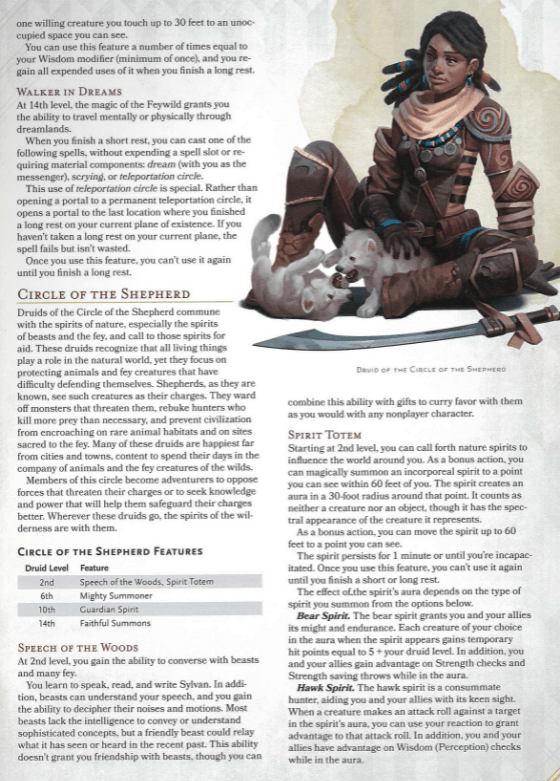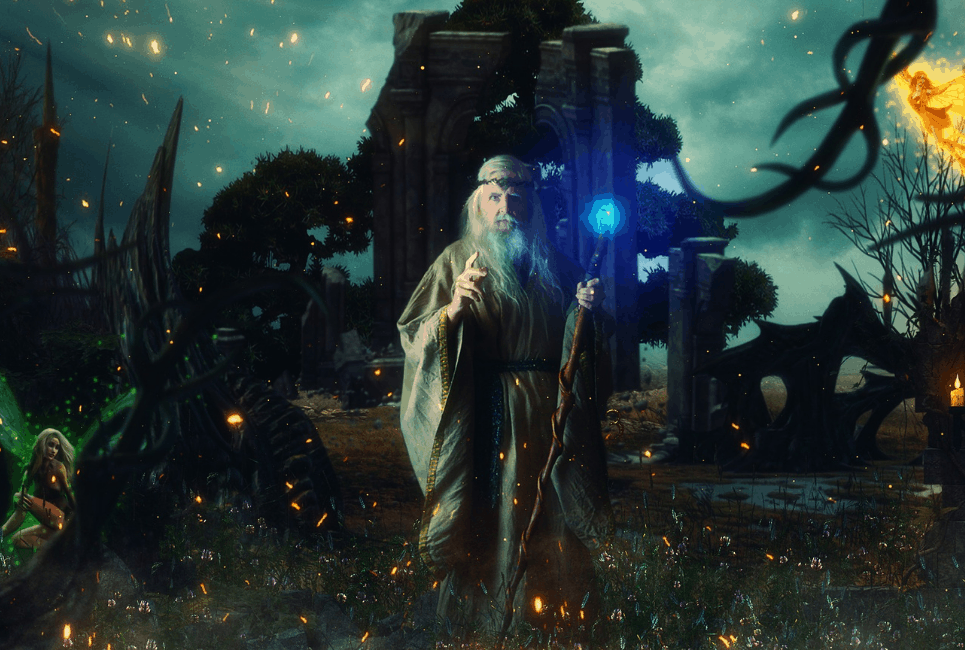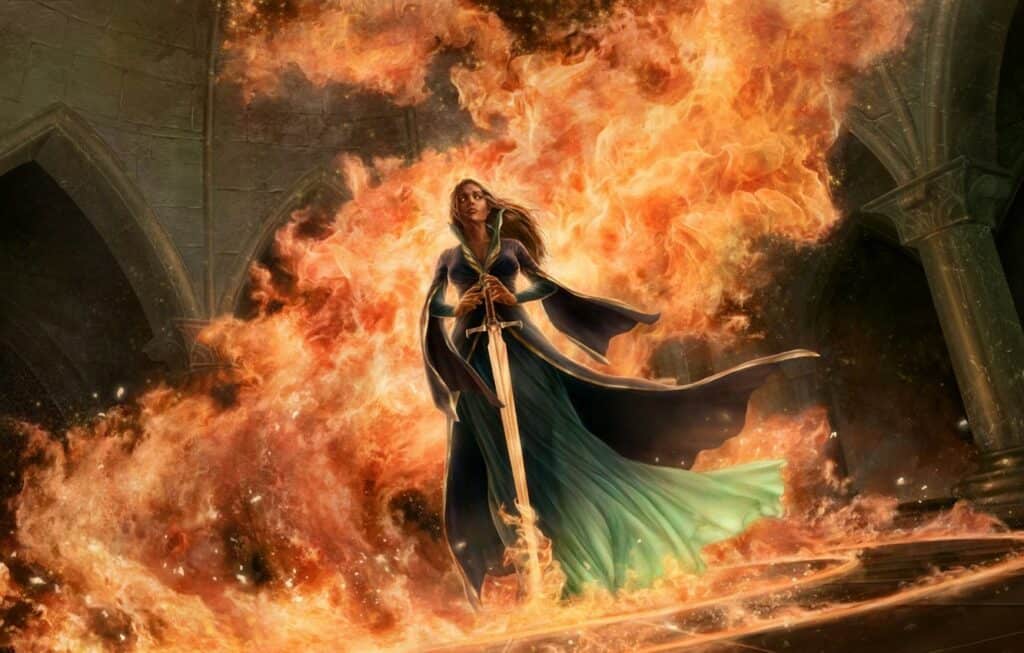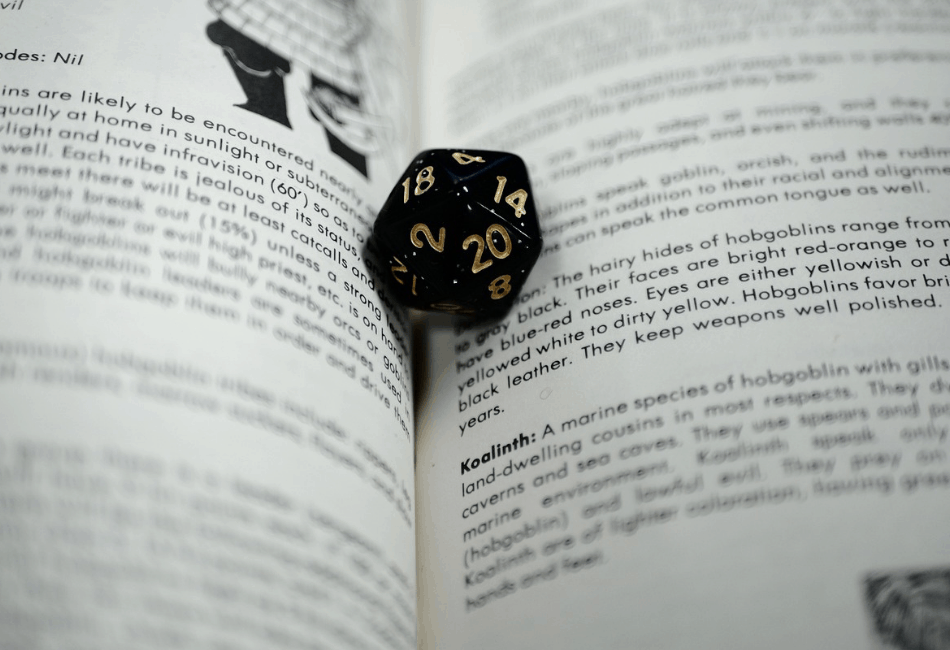The Circle of the Shepherd is a druid subclass that was published in the 5th edition supplement Xanathar’s Guide to Everything (XGE). It leans into the druid’s protective role over beasts and fey creatures. Many of the abilities revolve around the ability to summon additional allies and spirits to fight for.
In this Circle of the Shepherd Guide, we’ll see how this is a great pick for a druid that wants to play a good support role. If you play this D&D subclass, expect to sit back from the frontline, conjure allies, cast area of effect spells, and heal your party.
Circle of the Shepherd Features
At 2nd level, you learn the fey language Sylvan and the ability to communicate with beasts. While beasts can understand you, it will be up to your DM how much information you might be able to divine from the animals you come across.
You also gain a key feature for this class, the Spirit Totem. You are able to summon one of three spirit totems whose aura fills a 30-foot radius sphere. In most cases, this is large enough to cover the entire battleground. Summoning the spirit takes a bonus action, you can move it as a bonus action, it lasts for one minute, and you can use this ability once per short rest.
The three spirits you choose from are:
- Bear Spirit. You give temporary hit points to every creature you choose within the aura and you all gain advantage on Strength checks and Strength saving throws. While the Strength advantage is only really useful for allies who rely on grappling or shoving, the temporary hit points are increasingly useful the more allies you have.
- Hawk Spirit. Use your reaction to grant advantage on an attack and give your party advantage on perception checks. Since this uses your reaction, you can only grant advantage once per round but that is still very useful.
- Unicorn Spirit. Give your party advantage on all ability checks made to detect creatures and restore hit points to every ally in the aura when you cast a healing spell. With this, you can heal everyone in your party with a simple Healing Word.

At 6th level, you become a Mighty Summoner. Any creature you summon or create appears with 2 additional hit points for every hit die it has and their attacks are magical. Additional hit points combined with either the bear or unicorn spirit make your summoned creatures incredibly durable. Magical attacks are essential for your creatures to remain useful against higher CR monsters as most are resistant to non-magical attacks.
The Circle of the Shepherd subclass has grown in effectiveness with additional summoning spells added in the recent Tasha’s Cauldron of Everything (TCoE). However, many of these spells summon a creature with a static number of hit points. Therefore, they don’t seem to gain the additional hit points of the Mighty Summoner ability. Your DM might rule that you can add 2 hit points for every level of the spell or something similar.
At 10th level, your summoned creatures regain hit points equal to half your druid level when they end their turn in your aura. Regaining at least 5 hit points automatically every turn further increases their durability and highly encourages you to summon as many creatures as possible to benefit from this.
Lastly, at 14th level, you automatically summon four CR 2 creatures of your choice when you drop to 0 hit points or when you are unwillingly incapacitated. The creatures follow your commands or protect you if not commanded. The animals last for an hour and require no concentration, meaning that if you recover from being incapacitated, you can cast another summoning spell on top of this to have even more creatures out for the next hour.
Core Druid Abilities

In addition to your subclass features, you’ll want to make the most of your core class abilities. For the druid, that includes both your Wildshape ability and spellcasting.
Wildshape
While the Circle of the Shepherd leans more into spellcasting than Wildshaping, there are some ways to use this.
At low levels, transform yourself into a giant wolf spider to climb up walls and out of reach of melee attacks. This works best with the hawk spirit since you can continuously use your reaction to grant advantage to attacks. Unfortunately, you will also be out of range to use your action to attack. You can always drop down next to an enemy and use the Help Action to grant advantage on another attack.
As you reach the mid to high levels, you could pick creatures with high Strength scores and summon the bear spirit to grapple enemies. Make sure your party can follow it up with additional attacks.
By far, the best use of your Wildshape is the feature from TCoE Wild Companion that allows you to cast Find Familiar without any material components. Your familiar also benefits from all of the extra summoning abilities including more hit points and magical attacks.
Related read: Complete Brown Bear 5e Guide.
Spells
Since druids can prepare new spells every day, you won’t have to commit to a certain list of spells for the long haul. As you play, keep track of which spells you are using the most and which ones you need to get rid of. There are many spells like Animal Friendship that you might be expected to prepare because you’re a druid. The following spells are particularly useful for a Circle of the Shepherd druid.
Circle of the Shepherd druids are built around their abilities to conjure creatures in battle. You will spend most of your time at the backline summoning creatures, casting area of effect spells, and giving your allies the support they need.
At higher levels, you will find that you get a lot of mileage out of upcasting conjuration spells and you can instead prepare high-level non-concentration spells.
Cantrips
You start with two cantrips. Choose Guidance and Produce Flame. Guidance is a fantastic support option to constantly cast on your allies out of combat. Keep in mind that at higher levels, you won’t always be able to use this if you’re concentrating on maintaining a summoned creature. However, you can swap it out later if from the Cantrip Versatility feature. Produce Flame gives you a damaging cantrip that you can fall back on once you run out of spells.
1st Level Spells
Prepare Entangle to control the battlefield, Faerie Fire to deal with invisible creatures or to grant advantage on attacks and throw one down in the first round of combat. Prepare Healing Word to heal your allies with your bonus action and still cast a cantrip with your action. Your Unicorn Spirit makes Healing Word incredibly powerful and because it has a range and only requires a bonus action, it is a much better option than Cure Wounds.
Other great options include Absorb Elements to defend yourself against incoming elemental damage and Thunderwave if anyone gets too close to you. If you are the only spellcaster in your party, consider preparing utility options like Detect Magic. Otherwise, leave it to the wizard.
2nd Level Spells
Prepare Summon Beast, Spike Growth, Pass Without Trace, and Healing Spirit. You get your first summoning spell Summon Beast. Even without your Mighty Summoner abilities, this is a great option to throw into combat instead of yourself.
Spike Growth puts your enemies in a field of thorns that deals 2d4 damage every square they move and they move half as fast. Sit back and laugh as your allies pick them off with arrows before they get out of there.
Pass Without Trace gives your entire party a +10 to Stealth, making you collectively as stealthy as Batman. Healing Spirit is an ongoing effect that can heal 1d6 every turn.
3rd Level Spells

Prepare Conjure Animals, Summon Fey, Revivify, Lesser Resurrection, and Dispel Magic.
Conjure Animals is going to be one of your best spells. It lets you choose between summoning many weaker beasts or fewer stronger beasts. The DM ultimately determines which beasts you conjure but you should tell them what you are trying to summon. Choosing more creatures synergizes well with your bear and unicorn spirit and your other subclass features.
Summon Fey lets you summon a fey spirit to fight with you. This spirit teleports around the battlefield and attacks with a shortsword, dealing only slightly more damage than your summoned beast. Consider buffing your fey with a different weapon and how you might use their teleport utility. Otherwise, you can cast Summon Beast using a 3rd level spell slot.
Revivify brings someone back from the dead. It’s one of the most powerful 3rd level spells and the lowest-level resurrection spell.
Lesser Resurrection and Dispel Magic let you end ongoing magical effects. The former is limited to conditions that you or your allies might be suffering while Dispel Magic can be used to dispel any spell in the game.
4th Level Spells

Prepare Conjure Woodland Beings, Polymorph, Summon Elemental, and Wall of Fire.
Similar to Conjure Animals, Conjure Woodland Beings will be one of your most useful spells, allowing you to summon your choice of fey creatures. Again, choose the most amount of creatures you can. Additionally, if you summon any pixies, use them to constantly cast Polymorph on your enemies until you’re fighting a couple of frogs.
If you didn’t summon any pixies, cast Polymorph yourself to turn one creature into a small, harmless animal. This is a great way of disabling a powerful enemy while you deal with weaker enemies or while you run away.
Summon Elemental is another summoning spell from TCoE that summons a single elemental creature. It can be underwhelming in comparison to the other spells but gives you some unique options from a flying elemental to one immune to fire damage.
If you’re not summoning creatures, Wall of Fire is a great area effect to control a battle. Split the battlefield in half with a fiery barrier or encircle a group of enemies while you run away.
5th Level Spells
Prepare Greater Restoration and Reincarnate for healing, Conjure Elemental for a more powerful singular creature to summon, Scrying to spy on your enemies at any time of day, and Wall of Stone or Maelstrom for great area effects.
6th Level Spells
Prepare Heal for strong single-target healing, Heroes’ Feast to buff your entire party, and Wall of Thorns if you need to control the battlefield and too many things are resistant to fire damage.
7th Level Spells
Prepare Plane Shift for travel throughout the multiverse and Mirage Arcane to create an illusory fortress that can become real.
8th Level Spells
Prepare Feeblemind to disable a powerful enemy or Tsunami to throw your enemies away from you. Just be careful with the latter since it takes 1 minute to cast. You definitely shouldn’t cast it against anything like a gargantuan dragon since it won’t have any effect.
9th Level Spells
You’ll most likely want to prepare Foresight to buff an ally so you can remain in the backline. Otherwise, prepare Shapechange and get your hands dirty by transforming into a dragon.
Races
If you’re not using the Customized Origin feature from TCoE, prioritize races with a +2 to Wisdom. This includes Custom Lineage, Dhampir, Hexblood, Reborn, Firbolg, and Kalashtar.
If you are customizing your origin, the above options work well but other great options include the Aarakocra for flight, the Mountain Dwarf for two +2 bonuses, the Tortle to fix your notoriously low AC, or Warforged to gain durability and a boost to your AC.
Feats

Resilient Constitution. When you take this feat, your Constitution increases by 1 and you gain proficiency in Constitution saving throws, which are used for maintaining concentration on spells. Since you are relying on summoning spells, you will almost always be concentrating on a spell.
Metamagic Adept. Choose Extended Spell to double the lifespan of your summoned creatures.
Lucky. This is a great feat option for everyone and can be useful when maintaining concentration to keep those summoned creatures.
FAQs
Question: Can the Circle of the Shepherd Wildshape?
Answer: Yes, but the subclass is built around spellcasting, which you cannot do while in Wildshape. At higher levels, you can summon creatures to fight and use Wildshape to get yourself out of range of your enemies.
Question: Which book is the Circle of the Shepherd In?
Answer: It is published in Xanathar’s Guide to Everything.
Question: What can a shepherd druid summon?
Answer: Shepherd druids can summon a spirit totem at 2nd level that buffs every creature of their choice. In addition, they can cast many summoning spells such as Conjure Animals and Conjure Woodland Beings.
Question: Can I use a spirit totem while in Wildshape?
Answer: Yes. Summoning your spirit totem is not a spell so you can still activate it while in Wildshape.
Question: What are the druid circles?
Answer: The druid subclasses are called circles. There are seven official druid circles: Circle of the Land, Circle of the Moon, Circle of Dreams, Circle of the Shepherd, Circle of Spores, Circle of Wildfire, and Circle of Stars.
Question: How many spells can a druid prepare?
Answer: Each day, you can prepare a number of spells equal to your Wisdom modifier + your druid level. For example, a 3rd level druid with a Wisdom modifier of +3 can prepare six spells each day from the druid spell list.
Question: What race is best for druids?
Answer: The firbolg is a perfect race for a druid with innate nature magic and relevant ability score increases.
Circle of the Shepherd Guide: Summary
The Circle of the Shepherd druid is a powerful support spellcaster. You are able to keep your entire party alive with your spirit totem aura, grant advantage on attacks, and summon mighty creatures to swarm the battlefield.
Since 5th edition relies heavily on the action economy, you can single-handedly win many encounters by conjuring additional creatures to give your team more actions.
- Armor of Agathys 5e Guide: What is Armor of Agathys? - August 3, 2022
- Oath of the Ancients 5e Guide - August 3, 2022
- Dissonant Whispers 5e Guide - July 20, 2022

